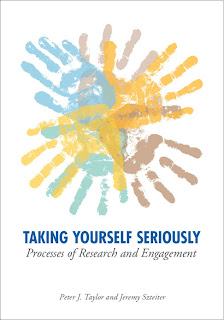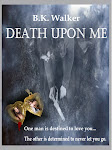Becoming aware of the forces that hold us or release
us
(an excerpt from
http://www.faculty.umb.edu/pjt/journey.html)
In the mid-1980s I was teaching science in its social
context as a new faculty member at a non-traditional undergraduate college. I
began an ecology course with a brief review of our place in space before I asked
students to map their geographical positions and origins. One student, "K," did
not come back to earth with the rest of us, but remained off in her own
thoughts. Some minutes later she raised her hand: "I always knew the sun, not
the earth, was the center of the solar system, but do you mean to say..." K
paused, then continued. "I'd never thought about the sun not being the center of
the universe." From K's tone, it was clear that she was not simply rehearsing a
new piece of knowledge. She was also observing that she had not thought about
the issue but now she saw as obvious that the universe was not sun-centered.
What other retrospectively obvious questions had she not been asking? What other
reconceptualizations might follow? These questions pointed her along the path I
hoped my students would take as critical thinkers-grappling with issues they had
not been aware they faced, generating questions beyond those I had presented,
becoming open to reconceptualization, and accepting that their teacher should
not be at the center of their learning.
Since childhood star gazing in rural Australia I had known about the sun's marginal place in the Milky Way so I felt some superiority when K admitted that she had not realized this. To my chagrin, I subsequently discovered my own retrospectively obvious question about our place in space. I was reading Sally Ride's 1986 book on the space shuttle to my child, when I came to her description of astronauts regaining weight as they descended. The idea conveyed was that weightlessness was a result of distance from the earth. Yet the space shuttle orbits only 300 kilometers up where the earth's gravity is still 90% of its strength down on the surface. So I started thinking about how to explain weightlessness correctly in a children's book. Try this-think of swinging an object around on the end of a piece of string. To make it go faster, you have to pull harder; if you do not hold on tight, the object flies off into the neighbor's yard. Astronauts travel around the earth fast-at 7.5 kilometers per second. They feel weightless because all of the earth's gravitational attraction on them goes to keep them from flying off into space. The earth's pull on the astronauts is like your pulling on the string-but, while you may let go, gravity never stops acting. When the space shuttle slows down on its return to earth, less of gravity's force goes to keeping the astronauts circling the earth and what is left over is experienced as weight regained.
After rehearsing this explanation a few times, another kind of weightlessness occurred to me. The sun's gravitational attraction is keeping me circling around it-at 30 kilometers/second I figured out. On the earth I feel weightless with respect to the sun's gravity, but that force is acting nevertheless. I had never thought about this; I had considered myself a passenger on the earth, which the sun's gravity was keeping in orbit around it. I then realized that I am also zooming around the Milky Way galaxy, not as a passenger in the solar system, which the galaxy's gravitational attraction was keeping in orbit around it, but because the galaxy's gravity is keeping me orbiting around its center. It made me feel woozy to think of the sun and the rest of the galaxy "paying attention to me" all the time, keeping me circling at enormous speed through space-at over 200 kilometers/second, I soon learned. I wondered if every molecule in the galaxy was attracting every molecule of my body every moment. Was there some other way to think about gravity? Perhaps a further radical reconceptualization awaited me, possibly involving wooziness-inducing Einsteinian concepts such as curved space-time.
Since childhood star gazing in rural Australia I had known about the sun's marginal place in the Milky Way so I felt some superiority when K admitted that she had not realized this. To my chagrin, I subsequently discovered my own retrospectively obvious question about our place in space. I was reading Sally Ride's 1986 book on the space shuttle to my child, when I came to her description of astronauts regaining weight as they descended. The idea conveyed was that weightlessness was a result of distance from the earth. Yet the space shuttle orbits only 300 kilometers up where the earth's gravity is still 90% of its strength down on the surface. So I started thinking about how to explain weightlessness correctly in a children's book. Try this-think of swinging an object around on the end of a piece of string. To make it go faster, you have to pull harder; if you do not hold on tight, the object flies off into the neighbor's yard. Astronauts travel around the earth fast-at 7.5 kilometers per second. They feel weightless because all of the earth's gravitational attraction on them goes to keep them from flying off into space. The earth's pull on the astronauts is like your pulling on the string-but, while you may let go, gravity never stops acting. When the space shuttle slows down on its return to earth, less of gravity's force goes to keeping the astronauts circling the earth and what is left over is experienced as weight regained.
After rehearsing this explanation a few times, another kind of weightlessness occurred to me. The sun's gravitational attraction is keeping me circling around it-at 30 kilometers/second I figured out. On the earth I feel weightless with respect to the sun's gravity, but that force is acting nevertheless. I had never thought about this; I had considered myself a passenger on the earth, which the sun's gravity was keeping in orbit around it. I then realized that I am also zooming around the Milky Way galaxy, not as a passenger in the solar system, which the galaxy's gravitational attraction was keeping in orbit around it, but because the galaxy's gravity is keeping me orbiting around its center. It made me feel woozy to think of the sun and the rest of the galaxy "paying attention to me" all the time, keeping me circling at enormous speed through space-at over 200 kilometers/second, I soon learned. I wondered if every molecule in the galaxy was attracting every molecule of my body every moment. Was there some other way to think about gravity? Perhaps a further radical reconceptualization awaited me, possibly involving wooziness-inducing Einsteinian concepts such as curved space-time.
In recent years I have started courses and workshops on
critical thinking by relating the reconceptualizations that occurred to K and
myself. I usually follow the story with an activity. My goal is to have people
respond to story and bring insights to the surface about how people can generate
questions about issues they were not aware they faced. The activity begins,
therefore, with a freewriting exercise in which each of us writes for ten
minutes starting from this lead off: "When I entertain the idea that I haven't
been asking some 'obvious' questions that might have led to radical
reconceptualizations, the thoughts/ feelings/ experiences that come to mind
include..." After this writing, we pair up and describe situations in which we
"saw something in a fresh way that made us wonder why we previously accepted
what we had." We then list on the board short phrases capturing what made the
"re-seeing" possible. The factors mentioned differ from one time to the next,
but they always represent a diverse mix of mental, emotional, situational, and
relational items, e.g, "relaxed frame of mind," "annoyed with this culture,"
"forgetting," "using a different vocabulary," and so on. I conclude the activity
by simply noting the challenge, which is common to many other questions in
education, of acknowledging and mobilizing the diversity inherent in any group.
Recently, however, now that I have lists from several occasions, I have started
to wonder whether the factors could be synthesized into general directions.
Would future audiences gain from my cutting through the diversity and presenting
such a synthesis-or does this run against the grain of facilitating thinking
about re-seeing?
A field-book of tools and processes to help readers in
all fields develop as researchers, writers, and agents of change A
wide range of tools and processes for research, writing, and
collaboration are defined and described-from Governing Question to
GOSP, Plus-Delta feedback to Process Review, and Supportive Listening
to Sense of Place Map. The tools and processes are linked to three
frameworks that lend themselves to adaptation by teachers and other
advisors:
- A set of ten Phases of Research and Engagement, which researchers
move through and later revisit in light of other people's responses
to work in progress and what is learned using tools from the other
phases;
- Cycles and Epicycles of Action Research, which emphasizes reflection and dialogue to shape ideas about what action is needed and how to build a constituency to implement the change; and
- Creative Habits for Synthesis of theory and practice.
Researchers and writers working under these frameworks participate in Dialogue around Written Work and in Making Space for Taking Initiative In and Through Relationships. These processes help researchers and writers align their questions and ideas, aspirations, ability to take or influence action, and relationships with other people. Bringing those dimensions of research and engagement into alignment is the crux of taking yourself seriously. The tools, processes, and frameworks are illustrated through excerpts from two projects: one engaging adult learning communities in using the principles of theater arts to prepare them to create social change; the other involving collaborative play among teachers in curriculum planning. A final section provides entry points for students and educators to explore insights, experiences, and information from a wider world of research, writing, and engagement in change.
Peter
Taylor:
Peter Taylor is a Professor at the University of
Massachusetts Boston where he directs the Graduate Program in
Critical and Creative Thinking and the undergraduate Program on
Science, Technology and
Values. His research and writing links innovation in teaching and interdisciplinary collaboration with studies of the complexity of environmental and health sciences in their social context. This combination is evident in his 2005 book, Unruly Complexity: Ecology, Interpretation, Engagement (University of Chicago Press).
Values. His research and writing links innovation in teaching and interdisciplinary collaboration with studies of the complexity of environmental and health sciences in their social context. This combination is evident in his 2005 book, Unruly Complexity: Ecology, Interpretation, Engagement (University of Chicago Press).
Jeremy
Szteiter:
Jeremy Szteiter is a 2009 graduate of the Critical and
Creative Thinking program and now serves as the Program's Assistant
Coordinator. His work has centered around community-based and adult
education and has involved managing, developing, and teaching programs to lifelong learners, with an emphasis on a learning process that involves the teaching of others what has been learned and
supporting the growth of individuals to become teachers of what they know.
education and has involved managing, developing, and teaching programs to lifelong learners, with an emphasis on a learning process that involves the teaching of others what has been learned and
supporting the growth of individuals to become teachers of what they know.
Title: Taking Yourself Seriously: Process of Research
and Engagement
Format: Print & Ebook
Genre:
Personal & Professional Development,
Research, Writing Skills
Publisher: The Pumping Station
Released: February 2012
Purchase Link:
http://thepumpingstation.org/books
or regular online retailers

































































0 comments:
Post a Comment